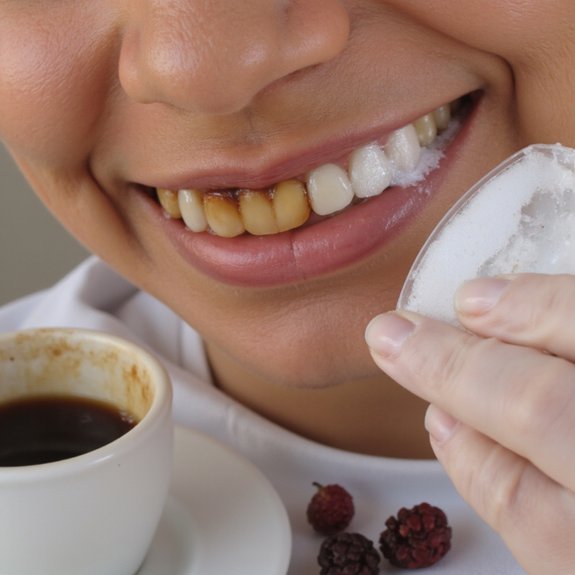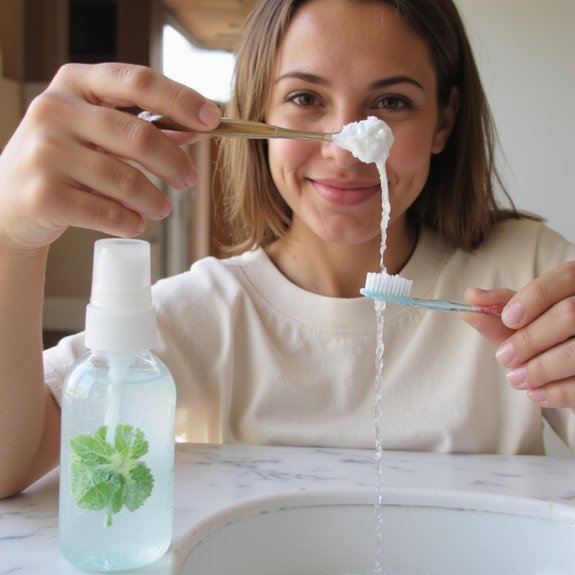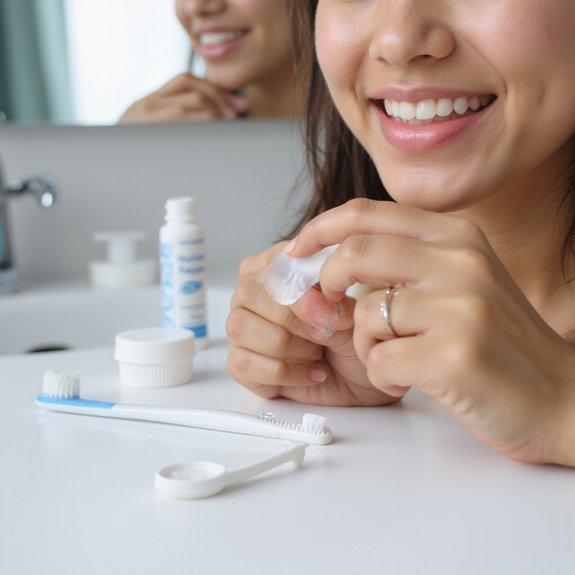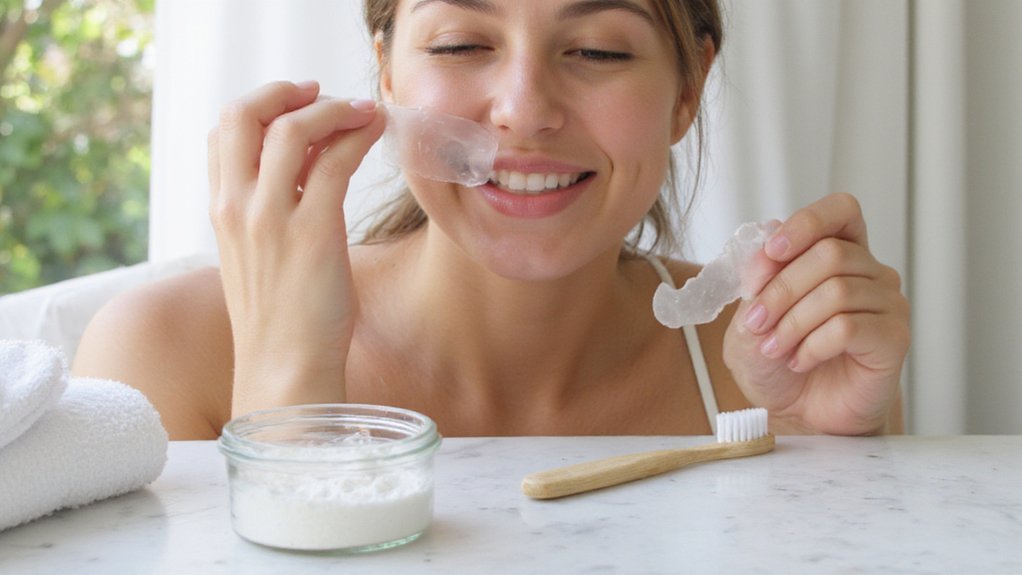You can safely improve tooth color at home, but results and risks vary with the method and your oral health. Over-the-counter peroxides, strips, and professional trays reduce stains by oxidation, yet they can cause sensitivity or gum irritation if misused. I’ll outline evidence-based options, expected results, and when you should see a dentist.
Key Takeaways
- See your dentist first to check restorations, cavities, and suitability for whitening.
- Use whitening toothpastes or rinses for mild extrinsic stains; they remove surface discoloration, not deep intrinsic stains.
- Apply peroxide-based strips, gels, or custom/OTC trays per instructions for gradual whitening over 2–4 weeks.
- Manage sensitivity with desensitizing toothpaste, shorter application times, or pause treatment and consult your dentist if persistent.
- Maintain results by limiting coffee, tea, red wine and smoking, rinsing after pigmented foods, and doing periodic touch-ups.
How Teeth Become Stained and Why Whitening Works

Stains on teeth arise from two main mechanisms: extrinsic discoloration when pigmented compounds from foods, beverages, tobacco, or bacterial biofilm adhere to the enamel surface, and intrinsic discoloration when staining agents become incorporated into the tooth structure (for example with aging, dentin darkening, tetracycline exposure, or fluorosis); enamel erosion can also reveal underlying yellowish dentin. You should first identify staining causes clinically and via history to select appropriate interventions. Extrinsic deposits respond to mechanical and chemical disruption, while intrinsic alterations require oxidizing agents that penetrate enamel and modify chromogens. Emerging protocols integrate safe concentrations, controlled exposure, and objective shade measurement; whitening science emphasizes dose, duration, and substrate characteristics. Be cautious: individual variability, restorative materials, and hypersensitivity affect outcomes. You can pursue evidence-based, innovative options in consultation with a dental professional to balance efficacy and safety. Always document baseline shades and monitor response objectively during any home whitening regimen.
Over-the-Counter Whitening Toothpastes and Rinses

You can use OTC whitening toothpastes and rinses to remove surface stains primarily through mild abrasion or by depositing optical agents on the enamel. Many products contain silica abrasives, enzymes, low‑concentration hydrogen peroxide or carbamide peroxide, or blue covarine-type compounds that shift perceived tooth color. Clinical studies show modest short-term gains for surface discoloration, but you should expect less whitening than professional peroxide treatments and monitor for sensitivity or increased abrasion.
How They Work
Although they’re marketed for whitening, over-the-counter whitening toothpastes and rinses work mainly by removing or masking extrinsic discoloration rather than changing tooth color intrinsically. You should view them as surface management: abrasives and optical agents lift stains from enamel and create temporary lightening effects. Clinical evidence supports modest improvements for surface stains with consistent use, but results vary by formulation and stain type. Don’t expect dramatic shade changes that alter dentin color. Consider them as maintenance adjuncts to professional care rather than primary treatments. Be cautious about overuse; increased abrasion can harm enamel and sensitivity. If you’re seeking innovation, evaluate products with transparent claims and published testing. Discuss expectations with a dental professional to align your goals with realistic, evidence-based outcomes and realistic timelines.
Active Whitening Ingredients
Over-the-counter whitening toothpastes and rinses rely on a small set of active ingredients—mild abrasives (hydrated silica, calcium carbonate), low‑concentration peroxides (hydrogen peroxide, carbamide in rinses or gels), optical modifiers (blue covarine or other light‑reflecting dyes), enzymes, and chelating agents (pyrophosphates, phosphates)—often combined with desensitizing agents like potassium nitrate. You can expect abrasives to remove surface stains mechanically, peroxides to deliver modest chemical bleaching, and optical modifiers to alter perceived color immediately. Evidence supports incremental whitening from these whitening agents, but results vary with formulation, wear time, and baseline staining. Prioritize ingredient safety: follow label concentrations and avoid prolonged use if you experience sensitivity or mucosal irritation. For innovation-minded readers, look for products with validated clinical data and transparent ingredient lists before adopting a regimen.
Whitening Strips and Gels: What to Expect

Whitening strips and gels use peroxide-based agents that penetrate enamel to oxidize pigmented molecules, and you’ll apply them according to the product protocol to achieve this effect. You’ll often notice incremental lightening within a few days, with typical courses lasting one to two weeks for over-the-counter products and longer for lower concentrations. Expect possible transient tooth sensitivity and gum irritation; stop use and consult your dentist if you experience severe or prolonged symptoms.
How They Work
Most strips and gels contain hydrogen peroxide or carbamide peroxide, which diffuse through enamel and dentin and oxidize pigmented molecules (chromogens), gradually lightening tooth color. You’ll apply a thin film that maintains contact, allowing peroxide to penetrate and break double bonds in stain molecules. Concentration, contact time and formulation determine effect size and sensitivity risk; you should follow manufacturer or clinician guidance rather than experimental home remedies or unvalidated whitening techniques. Expect transient sensitivity and uneven uptake on restorations. Monitor for mucosal irritation and discontinue if severe.
- A clear gel embracing tooth surfaces
- Microscopic peroxide molecules moving through enamel
- Temporary nerve hyper-responsiveness with cold
- Differential staining between natural enamel and crowns
This is clinical, evidence-based, and cautious. Consider professional consultation for optimized, innovative protocols.
Timeline for Results
You’ll typically notice the first signs of lightening within 3–7 days, with the most noticeable change appearing after 2–4 weeks of regular daily use; the speed and degree of whitening depend on peroxide concentration, contact time, baseline stain type, and individual enamel characteristics. In practical terms, you should set conservative results expectations: many users achieve several shades improvement over weeks, but variability is high. Track progress with photographs and shade guides to quantify timing effects and avoid false impressions. Clinical studies suggest incremental improvement over repeated applications rather than immediate dramatic shifts. If you pursue higher-concentration products or longer protocols, do so under guidance and reassess progress regularly. This evidence-based, measured approach aligns with innovative goals while prioritizing predictable outcomes. Expect modest, verifiable change.
Sensitivity and Side Effects
Although usually transient, tooth sensitivity and soft-tissue irritation are the most common adverse effects of at-home strips and gels, and you should expect them to occur in a measurable minority of users. You’ll likely notice brief thermal or tactile sensitivity during treatment; research shows this peaks early and often resolves within days after stopping. To minimize sensitivity concerns and other side effects, follow product timing, avoid overuse, and consider desensitizing toothpaste. If irritation persists beyond two weeks, consult a clinician. Seek help.
- Cold or hot discomfort when biting
- Gum redness or mild ulceration near strip edges
- Temporary increased tooth pain with brushing
- Uneven whitening from inconsistent application
Monitor symptoms, stop use if severe, and report persistent reactions for professional assessment.
At-Home LED and Tray-Based Kits
When used as directed, at-home LED and tray-based kits deliver low- to moderate-concentration peroxide gels into contact with tooth surfaces, and the light is purported to accelerate whitening though evidence for added benefit of LED is mixed. You apply them per manufacturer timing; results are modest and variable. LED Technology may shorten sessions in some studies, but randomized trials show inconsistent advantage. Tray Design influences gel contact and soft-tissue protection; poor fit increases irritation and reduces efficacy. Expect incremental shade gains over days to weeks; sensitivity is common and typically transient. Choose lower concentrations if you have restorations or high sensitivity, and stop if pain persists. Track progress with shade guides or standardized photos and consider dental consultation for complex cases. Remain cautious.
| Feature | Typical level | Clinical note |
|---|---|---|
| Peroxide concentration | 3–10% | Lower than in-office |
| LED Technology | Variable evidence | Small or inconsistent benefit |
| Tray Design | Fit-dependent | Affects gel contact/sensitivity |
Professional Take-Home Trays vs. Store-Bought Options
When choosing between professionally made take-home trays and store-bought options, you should consider tray fit and comfort because ill-fitting trays can reduce gel contact and increase soft-tissue irritation. Professional trays typically allow for higher peroxide concentrations and more controlled application, which can improve results but raise cost, while over-the-counter kits offer lower-strength gels and greater convenience. Compare expected efficacy, budget, and lifestyle to select the option that balances safety, comfort, and the results you need, and consult your dentist if you experience sensitivity or have restorations.
Tray Fit and Comfort
1 key difference in tray fit is that professionally made take-home trays are custom-molded to your teeth, so they seat precisely, distribute peroxide gel evenly, and minimize excess gel contact with gums. You’ll notice a measurable custom fit and improved comfort level, reducing soft-tissue irritation in trials. If you choose over-the-counter trays, expect compromises in adaptation and potential gel pooling. Clinically, precise fit lowers risk of sensitivity and mucosal exposure; studies suggest individualized trays improve tolerability. When evaluating options, weigh fit, material flexibility, and hygienic maintenance. Use conservative application times until you confirm tolerability.
- snug contact against tooth surfaces
- minimal gum blanching or gel overflow
- even gel distribution along margins
- flexible but stable material that seats fully
If unsure, consult your dental professional today.
Whitening Strength Comparison
Most comparative studies show professionally dispensed take-home systems produce larger, more predictable shade changes than over-the-counter products because they combine higher, clinician-prescribed peroxide concentrations with controlled contact time and custom trays. When you choose between professional take-home trays and store-bought options, consider concentration, contact time, and tray fit as primary effectiveness factors. You’ll get more predictable results with clinician oversight; however, sensitivity risk rises with higher peroxide levels, so proceed cautiously. Emerging formulations and monitoring technologies can optimize outcomes, but you should follow evidence-based protocols and consult your provider.
| Feature | Typical Profile |
|---|---|
| Peroxide concentration | Professional: higher; OTC: lower |
| Contact control | Custom trays vs generic strips |
| Predictability | Greater with clinician oversight |
| Sensitivity risk | Increases with strength |
This whitening methods comparison targets measurable variables, not claims.
Cost, Convenience, Results
Although professional take-home trays cost more upfront, they deliver more predictable and typically faster shade changes because clinicians control peroxide concentration, contact time, and tray fit. You should weigh the cost comparison against long-term efficacy: trays often require fewer applications and yield measurable shade gains in controlled trials, while over-the-counter kits reduce initial expense but vary in results. Consider convenience factors like application time, storage, and reordering. Expect professional systems to demand clinic visits for impressions and occasional adjustments; OTC products let you start immediately but may need prolonged use. Visualize usage scenarios:
- Nightly tray wear after an initial fitting
- Daily short-session OTC strips on the commute
- Periodic professional touch-ups in clinic
- Repeat OTC purchases from retail
Track sensitivity and shade objectively during treatment.
Natural and DIY Whitening Methods: Risks and Benefits
Because DIY whitening methods promise quick, low-cost results, you may be tempted to try baking soda, activated charcoal, oil pulling, or diluted hydrogen peroxide at home. You can experiment with charcoal toothpaste or swish coconut oil, but evidence is limited and risks exist. Abrasive agents like baking soda and activated charcoal can remove surface stains yet also erode enamel and increase dentin exposure, raising sensitivity. Oil pulling shows modest antimicrobial effects but lacks robust clinical data for whitening. Diluted hydrogen peroxide can lighten stains but requires concentration control to avoid mucosal irritation and uneven shade. If you innovate, do so cautiously: use dentist-recommended concentrations, limit frequency, and monitor for sensitivity, gum inflammation, or enamel change. Seek professional guidance before persistent use, especially if you have restorations, crowns, or periodontal disease. A clinician can advise safer protocols or supervised in-office options that balance efficacy and tissue preservation and aesthetics.
How Long Results Typically Last and What Affects Longevity
When you undergo whitening, results typically last from a few months up to several years depending on the method and your habits. You should expect variability: in-office peroxide systems tend to maintain shade longer than over-the-counter strips; natural approaches typically yield shorter duration. Key determinants include staining mechanism, initial shade, frequency of touch-ups, and adherence to long term maintenance. You can influence outcomes by modifying lifestyle habits and scheduling evidence-based top-ups.
- a morning coffee that gradually reintroduces brown chromogens
- habitual red wine evenings staining enamel pellicle
- daily tobacco exposure depositing persistent pigments
- periodic professional or supervised home top-ups to restore shade
Clinical trials document regression over months; apply results cautiously, track objective photos, and collaborate with a clinician to design an innovative, personalized maintenance plan. You should reassess progress periodically and adjust frequency based on measurable relapse and preferences.
Safe Use: Protecting Enamel and Preventing Gum Irritation
Maintaining whitened teeth requires attention to safety: overuse or improper application of bleaching agents can erode enamel and provoke gingival irritation, so you should follow recommended concentrations, exposure times, and device-fit guidelines. Use lower-concentration products, limit frequency, and pause if sensitivity arises. Focus on enamel protection and proactive gum health: apply barriers, verify trays fit, and avoid contact with soft tissue.
| Risk | Preventive Step | Evidence/Note |
|---|---|---|
| Enamel erosion | Use ≤10% peroxide, short duration | In vitro and clinical data support reduced risk |
| Gum irritation | Use custom-fit trays or barriers | Limits chemical contact with gingiva |
| Sensitivity | Desensitizing toothpaste pre/post | Potassium nitrate or fluoride reduces symptoms |
| Overuse | Follow product protocol, max cycles | Innovative LED adjuncts don’t offset misuse |
Stop treatment and consult a clinician for persistent pain; adopt measured, data-driven protocols to innovate safely. You should monitor progress, document sensitivity episodes, and adjust regimen based on objective outcomes and new evidence regularly.
When to See a Dentist Before Whitening
If you have dental restorations, active caries, periodontal disease, enamel defects, or unexplained tooth pain, see your dentist before starting whitening. You should get a professional exam that assesses sensitivity, restoration margins, and baseline enamel condition; evidence supports fixation of disease before bleaching to protect oral health. A consultation importance can’t be overstated: your clinician will identify contraindications and recommend formulations or deferred timing.
During evaluation you’ll see descriptive findings and targeted options:
- Close inspection of crowns, veneers, and composite edges under bright light.
- Probing depths and bleeding points to reveal periodontal activity.
- Photographs and shade mapping to document baseline color.
- Sensitivity tests and enamel defect assessment with periapical imaging when needed.
If you’re seeking innovative at-home protocols, rely on this clinical gatekeeping. It reduces adverse outcomes, optimizes efficacy, and guarantees whitening complements, rather than compromises, your oral health. Discuss risk-benefit and timing during your consultation visit today.
Tips for Maintaining a Brighter Smile After Treatment
After your clinician has addressed restorations and oral disease, you should follow targeted measures to preserve whitening results and minimize retreatment. You’ll want a protocol that balances efficacy with enamel safety: brush twice daily using a soft brush and fluoride toothpaste, avoid aggressive scrubbing, and use touch-up trays or milder at-home gels as recommended. Monitor sensitivity and pause treatment if pain or ulceration occurs. Emphasize maintaining habits such as smoking cessation and daily interdental cleaning; these reduce staining recurrence. Implement pragmatic diet changes—limit coffee, tea, red wine, and acidic foods—and rinse after pigmented meals. Schedule periodic professional assessments every 6–12 months to evaluate shade stability and restorations. Adopt emerging adjuncts cautiously, only with clinician approval. Below is a quick reference for routine actions.
| Action | Frequency |
|---|---|
| Oral hygiene | Daily |
| Diet moderation | Ongoing |
| Professional review | 6–12 months |
Document changes and photograph shades to inform evidence-based adjustments to your maintenance plan regularly.
